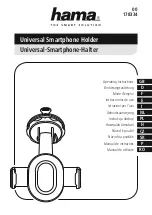
Some menus/features are operator dependent.
Guidelines for Safe and Efficient Use
This is the Internet version of the user’s guide. *Print out for private use only
5
CONTAIN SMALL PARTS THAT COULD BE
DETACHED AND CREATE A CHOKING
HAZARD.
Disposing of the Product
Your mobile phone should not be placed in municipal
waste. Please check local regulations for disposal of
electronic products.
Power Supply
Connect the AC power adapter only to designated power
sources as marked on the product. Make sure the cord is
positioned so that it will not be subjected to damage or
stress. To reduce risk of electric shock, unplug the unit
from any power source before attempting to clean it. The
AC power adapter must not be used outdoors or in damp
areas. Never alter the cord or plug. If the plug will not fit
into the outlet, have a proper outlet installed by a
qualified electrician.
Emergency Calls
Mobile phones operate using radio signals, which cannot
guarantee connection under all conditions. Therefore
you should never rely solely upon any mobile phone for
essential communications (e.g. medical emergencies).
Emergency calls may not be possible on all cellular
networks or when certain network services and/or mobile
phone features are in use. Check with your local service
provider.
Battery Use and Care
Charge the battery for 4 hours before you use your
mobile phone for the first time. The battery can only be
charged in temperatures b5°C (+41°F) and
+45°C (+113°F).
A new battery or one that has not been used for a long
time could have reduced capacity the first few times it is
used.
The talk and standby times depend on the actual
transmission conditions when using the mobile phone. If
T206cug_R2_ae.book Page 5 Friday, August 9, 2002 3:09 PM













































